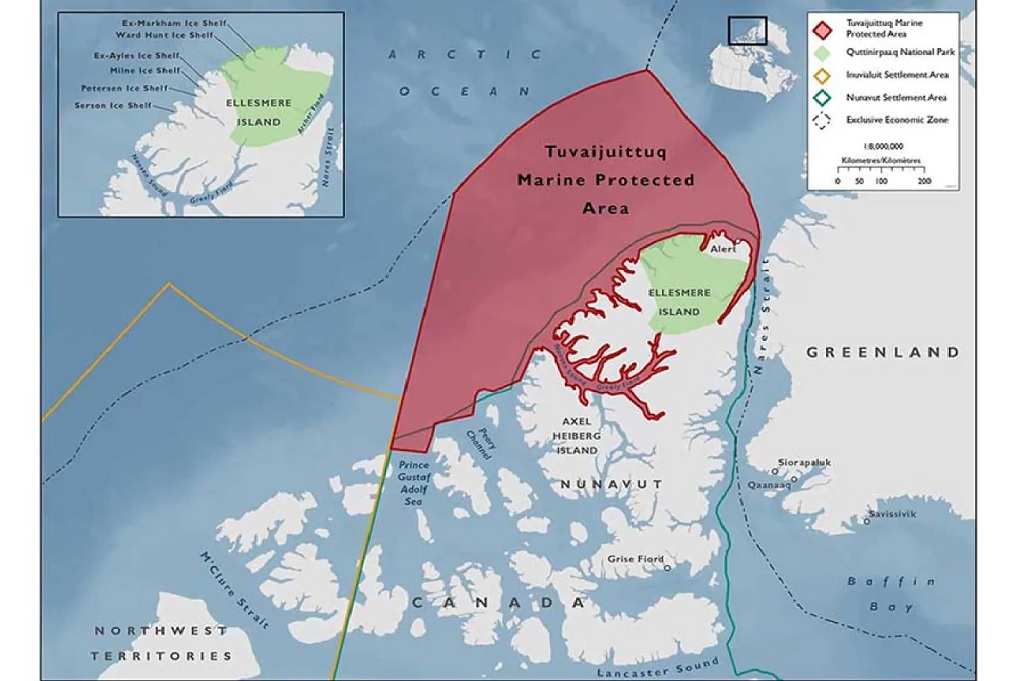For an Arctic scientist, seeing a giant 4,000 year old huge sheet of ice just disappear, is shocking. That’s what two Canadian researchers have seen, and in more than one instance.
Warwick Vincent is a biology professor at Laval University’s Centre for Northern Studies and has carried out research in the high Arctic for over two decades. Derek Mueller is an associate professor at the Water and Ice Research Laboratory, Department of Geography and Environmental Studies, Carleton University.

Warwick Vincent, ” All the models indicate that the northern latitudes will show the greatest and most rapid climate change. And we have seen some spectacular changes. So much of the landscape depends on ice, and we’ve seen ice-covered lakes that have been frozen for a thousand years suddenly become open water”: (via Parks Canada)
In a recent commentary published in the journal Science, they report that the northern edge of the Canadian Arctic archipelago and Greenland is where the world’s oldest and thickest ice is found. They also say it will be the last refuge for ice-dependent species. The commentary was titled, “Witnessing Ice Habitat Collapse in the Arctic”
They note that in summer 2020, the Milne Ice shelf collapsed losing 43 per cent of its expanse.

Researchers on the vast expanse of the Milne Ice Sheet 2018 (Jeremie Bonneau)
The Ward Hunt Ice Shelf, the largest landfast area of ice collapsed into ice islands in the summers of 2011 and 2012. Only small segments remain on the sides of the bay, The ice had been damming a freshwater lake which drained and disappeared when the shelf began to crack in 2002. The Serson Ice Shelf lost 121 square kilometres of its extent. And the 10-storey high Markham Ice Shelf which Vincent worked on in 2007, had disappeared when he returned in 2008.

Ice shelf locations, Ellesmere Island (ECCC)
With global warming this area of the Arctic has been determined to be where the last multi-year ice will be found as other long-term ice melts around the Arctic. It has thus been dubbed ‘the last ice area’.

Looking west across the Markham Ice Shelf in April 1984; Harold Serson kneeling in the left foreground ( D Meuller et al Nov 2006)
In spite of that they say it ancient ice sheets in the area are breaking up and although resistant to warming, even this area is not immune.
In addition to the break-up of several of the ancient ice sheets, they give as an example Ward Hunt lake which in the 1950’s was covered with ice still four metres thick in the 1950’s. Subsequent observations showed ice thinning and in 2016 there were 31 days of ice-free conditions.

Ward Hunt Lake in the 1950’s was covered with 4m thick ice even in summer. It’s been ice free in summer three times now. ( Warwick Vincent via Parks Canada)
In 2017, American researcher, Mark Serreze had predicted that the St Patrick’s Bay icecaps on Ellesmere Island would be gone in five years. In fact, they were declared gone in August of this year.
While there is a national park (Quttinirpaaq) and the ocean area has been designated as a marine protected area (MPA), the latter only extends until 2024. The two Canadians say the MPA known as Tuvaijuittuq, should be made permanent. Not only that but indeed extended across northern Canada and work with Greenland’s officials to extend it into Greenland. This would include the entire thick ice zone and coastal areas from additional stressors such as shipping and resources development.

Ellesmere Island: The MPA in red, national park green ( DFO)
The scientists note that there have been recent discoveries of species in this area that exist nowhere else, and that more research is needed before the ecosystems disappear. In fact they say serious efforts are needed to meet climate goals set by the Paris Accords if that disappearance is to be prevented.
Additional information-sources
- Science: Vincent/Mueller: Nov 27/20: Witnessing ice habitat collapse in the Arctic
- Nunatsiaq News: D Patar : Dec 1/20: As high-Arctic ecosystems collapse, scientists call for increased protection
- CBC: H Bird: Nov 26/20: Scientists urge federal government to ramp up conservation efforts in eastern Arctic
- CBC: H Paulson: Aug 7/20: Collpased Arctic ice shelf adds ‘exclamation point’ to dire climate trends, say scientists
- Associated Press (NBC News): Sep 3/08: Huge ice shelf breaks loose in Canadian Arctic







For reasons beyond our control, and for an undetermined period of time, our comment section is now closed. However, our social networks remain open to your contributions.